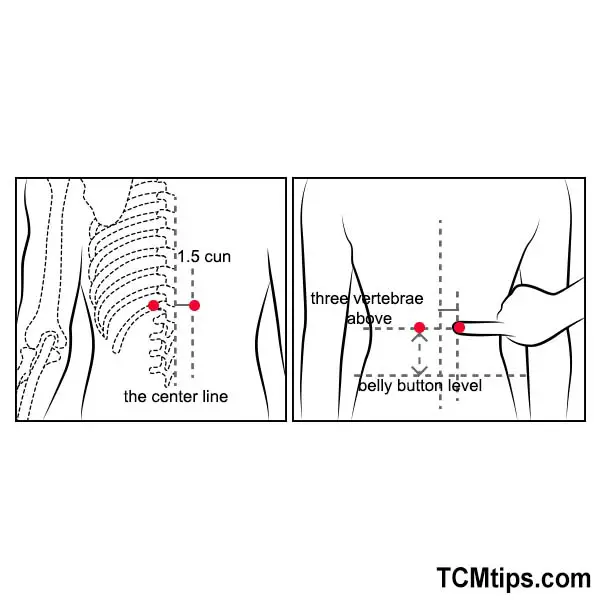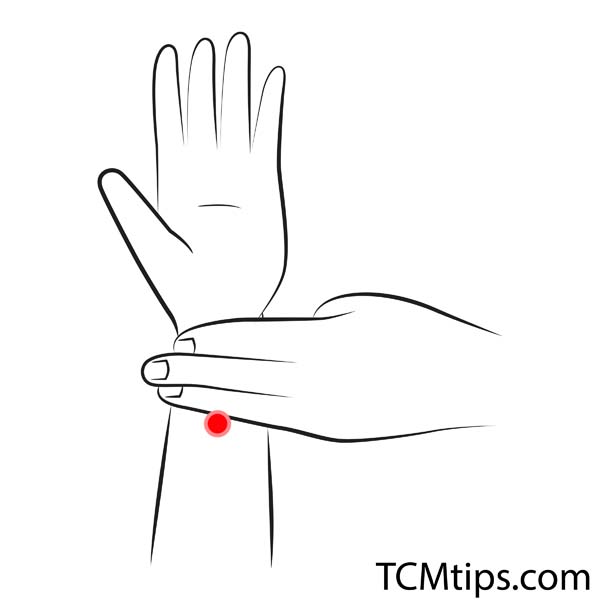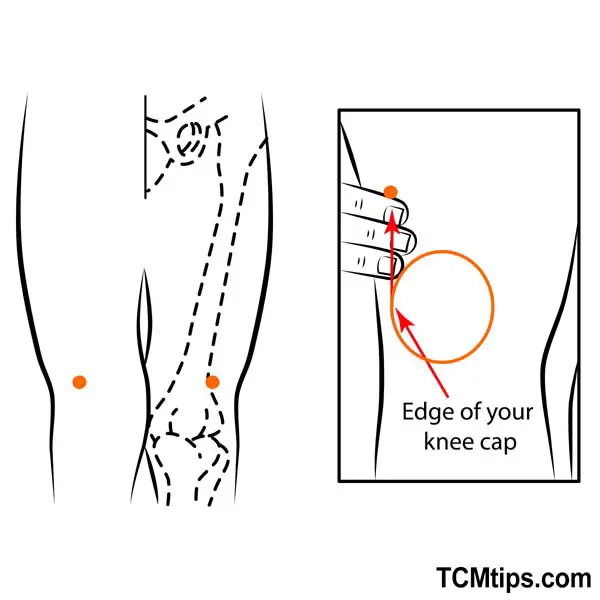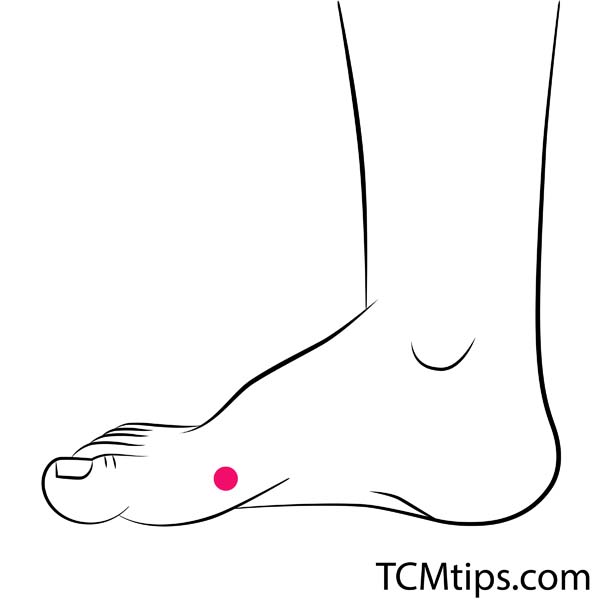Ease Digestive Discomfort: Discover 8 Pressure Points For Indigestion Relief
Everybody has had at least one experience of getting overexcited over a certain food and eating more than the body can handle. This is a rare situation for some people, but for others, this can be recurrent and associated with psychological and emotional problems. In both cases, when you put too much food in your stomach it can’t function properly. The Spleen in Chinese medicine theory is an important organ responsible for digestion along with the Stomach, and our eating behaviors directly affect these two organs equally. You can use some pressure points for indigestion to help your system in an overindulgent situation.
Where Are The Pressure Points For Digestion?
Acupoint: BI-20 (Other Names: Urinary Bladder-20/Pi Shu/Spleen Transporter)

Pishu, as this acupoint is also called, is located on the back, two finger-breadth from the eleventh thoracic vertebra.
Pishu is known as the back-shu point of the Spleen channel. As mentioned before, the Spleen in Chinese medicine is a digestive organ, but in this case, Spleen refers not to the spleen itself but rather to the gastrointestinal system as a whole. The back-shu acupoint of the Spleen is where the Qi emerges from the inside to the exterior. It is a strategic point from which it is possible to send Qi to the digestive system. In other words, Bl-20 can be said to be a key point that improves digestion and absorption of nutrients. This is one of the acupressure points for stomach inflammation.
Press this acupoint deeply for a few seconds and then release. It’s recommended that you do this stimulation for at least three minutes per session.
Acupoint: Bl-21 (Other Names: Urinary Bladder-21/Wei Shu/Stomach Transporter)

Bl-21 can be found on your back, two finger-breadth from the twelfth thoracic vertebra.
This point belongs to the Back-shu category, which is a series of points from the Urinary Bladder channel that have deeply nourishing properties. Bl-21 is the Back-shu of the Stomach. Scientific research suggests that this acupoint improves digestion by stimulating the production of gastrin, an important hormone that modulates the release of gastric acid for digestion and absorption of nutrients. This acupoint is said to be helpful in digestive disorders. It is effective for heaviness in the stomach, upset stomach, sudden stomach pain, etc. You can also use Bl-21 in back pressure points massage.
Press this acupoint deeply for a few seconds and then release. Repeat this for about three minutes.
Acupoint: Bl-50 (Other Names: Urinary Bladder-50/Wei Cang/Stomach Granary)

Bl-50 is located on the back, four finger-breadth from the twelfth thoracic vertebra, level with Bl-21.
This point is also called weicang, “Stomach Granary” because it harmonizes the gastrointestinal system releasing symptoms like abdominal fullness, distention, difficult ingestion, nutritional impairment in children, etc. It is effective for a heavy stomach and loss of appetite due to overeating or eating too much cold foods, and it has the effect of enhancing the activity of the exhausted digestive system.
When stimulating the Bl-50, place your hands behind your back and gently press and knead with your thumbs. For those who find it difficult to press with their fingers, a tennis ball or baseball can be used to stimulate them easily. In that case, it is a good idea to lie on your back and place the ball under your body so that the ball is in the position of the acupuncture point. It’s recommended that you do this stimulation for at least three minutes per session.
Acupoint: PC-6 (Other Names: Pericardium-6/Nei Guan/Inner Pass)

This point is located at three finger-breadth from the crest of your wrists, on the midline of your forearm.
PC-6 is an outstanding point that is very effective in the treatment of a large number of disorders, from emotional and psychological problems to stress and headache. It is especially useful for relieving digestive system symptoms, such as stomach aches. It can also be expected to be effective for digestive system impairments caused by mental troubles. Among the gastrointestinal symptoms that PC-6 helps to release are Spleen and Stomach Qi Deficiency with fullness and distention, low-grade abdominal pain, abdominal masses, focal distention, and diarrhea. PC-6 is also one of the acupressure points for gastritis.
Press on this point on your wrists using your thumbs and create circular motions. Do this stimulation for at least three minutes per session, up to three sessions per day.
Acupoint: ST-34 (Other Names: Stomach-34/Liang Qiu/Ridge Mound)

ST-34 is located 3 finger-breadth superior to the lateral superior border of the patella on your tights.
This is a specific point where the Stomach meridian’s Qi flowing superficially along the channel gathers and plunges more deeply into the body. It can be used to treat acute stomach pain. It’s important to note that it is said that the stimulation of this acupoint inhibits intestinal peristalsis. You can also use ST-34 as one of the acupressure points for gallbladder inflammation.
Press on this point for a few seconds, releasing it intermittently for about three minutes. This point can be painful when pressed too hard, so be careful.
Acupoint: Ren-12 (Other Names: The Conception Vessel-12/Zhong Wan/Middle Epigastrium)

This point is located four cun above the navel, on the midline of the abdomen.
Ren-12 has a special connection with the two main organs responsible for digestion, according to the Chinese system, the Stomach and Spleen. It helps to treat all diseases of the Stomach and Spleen, from interior injury to epigastric pain and fullness, difficult ingestion, including when one eats little but is easily full, and also nausea, stomach reflux, vomiting, vomiting blood, abdominal distention, severe pain of the abdomen, sudden abdominal fullness, focal distention, hardness and pain of the lateral costal region, etc. Ren-12 is also used in acupuncture for a brain tumour.
This point is located on the abdomen, so apply gentle pressure. You can tap on it for about three minutes using your index and middle fingers instead of pressing if you prefer.

Acupoint: ST-36 (Other Names: Stomach-36/Zu San Li/Leg Three Miles)

ST-36 can be found when you place your four fingers immediately below your kneecap and one finger-breadth on the side of the tibia’s anterior crest.
ST-36 has been known since ancient times as an acupuncture point that helps with all digestive issues. It has been confirmed that when acupuncture is applied to ST-36, the stomach releases more gastrin, an essential hormone for digestion. Acupuncture at ST36 is able to improve rectal distention, as well as upper and lower gastrointestinal symptoms and impairment in gastric slow waves, by enhancing the activity of the vagus nerve, an important nerve of the parasympathetic branch of the autonomic nervous system. It is also safe to use ST-36 in acupressure for stomach pain in children.
Press this acupoint deeply for a few seconds and then release. Repeat this for about three minutes.
Acupoint: SP-3 (Other Names: Spleen-3/Tai Bai/Great White)

Find this point around the bottom of the protruding bone at the base of the thumb.
SP-3 is a potent acupoint that helps to recover digestive function in people who have busy lives and whose jobs are stressful and require a lot of mental activity. The stimulation of this point is expected to help calm the mind as well, besides stimulating the pancreas in diabetic people and reducing insulin intake. It is said to promote the function of digestion and absorption and is effective for stomach heaviness and loss of appetite. If you press it before a meal, you can expect a preventative effect that adjusts the condition of your stomach and intestines. This is one of the acupressure points for Spleen inflammation.
In a comfortable position, press this acupoint firmly for a few seconds and then release, repeating this for about three minutes.
What Is The Cause Of Indigestion?
According to Oriental medicine, the Stomach should be divided into three parts, one part is to be filled with food, another one with liquids, and the third part should always remain empty. Problems arise when we fill up our Stomachs with too much food and liquids. If we do this too often, it increases the likelihood of our stomach becoming permanently distended and also increases the risk of developing obesity and other undesirable medical conditions.
Even if you happen to overeat just once in a while every so often, it can have distressing effects. According to Chinese medicine, digestion is carried out primarily by the Stomach and its yin/yang paired organ, the Spleen. The function of the Stomach in TCM is to receive the foods and liquids and separate their essence, and the function of the Spleen is to absorb the essence of the substances in the Stomach to transform them into Qi and Blood.
When we eat more than our digestive system can handle, the food can get stuck in the Stomach creating too much bacteria. In Chinese medicine, this process is said to happen due to the development of Humidity in the Stomach. When this happens, the function of the Spleen becomes impaired as there’s a higher demand for Qi in order to transform this Humidity, as this is not the original function of the Spleen. In both traditional and Western medicines, binge eating is unanimously considered unhealthy and something to be avoided. The acupressure points for indigestion stimulate the digestive organs and other elements of the body that are related to them, eliminating the common symptoms related to indigestion.
Does Acupuncture Help With Indigestion?

Acupuncture is the main treatment for indigestion in TCM after herbal therapy. There are points along the meridians that can be used specifically to release the gastrointestinal system in cases of overeating. Recently, some scientific studies have been carried out in an attempt to measure the effects of these acupuncture points on indigestion in laboratory and clinical settings. The results of these studies indicate that acupuncture has a regulatory effect on gastrointestinal motility.
Yet another scientific research that has been carried out in China pointed out that acupuncture improves the symptoms of patients with postprandial distress syndrome, which is a subtype of dyspepsia. Besides the limited perspective of science on the effects of indigestion pressure points, the practice of acupuncture has reached the West with full strength. There’s a lot of practical experience that points to the effectiveness of therapy with pressure points for indigestion.
Takeaways
Chinese medicine offers a holistic treatment for indigestion due to overeating, however, the treatment with pressure points for indigestion should not replace prevention and healthy eating habits, nor medical attention. There is significant research showing the long-term benefits of acupuncture on pressure points for indigestion. An acupressure treatment, when properly done is expected to ameliorate indigestion.
- Bl-20 improves the gastrointestinal system as a whole, improving digestion and absorption of nutrients.
- Bl-21 improves digestion by stimulating the production of gastrin.
- Bl-50 harmonizes the gastrointestinal system releasing symptoms in this area.
- PC-6 is effective for digestive system impairments caused by mental troubles, such as stomach aches and headaches.
- ST-34 treats acute stomach pain.
- Ren-12 helps to treat all diseases of the Stomach and Spleen.
- ST-36 enhances the activity of the vagus nerve and regulates the parasympathetic system.
- SP-3 promotes the function of digestion and absorption and is effective for stomach heaviness and loss of appetite.

Try our Anti-Aging Gua Sha Tool designed to bring out your skin’s natural glow.
Best Gua Sha Product- Anti-Aging: The tool is designed to target 11 specific aging signs such as wrinkles and sagging skin. By following the 7-step routine, users can improve skin firmness and reduce fine lines naturally.
- Enhances Skincare Routine: It works effectively with serums and lotions, boosting absorption and efficacy of skincare products.
- Visible Skin Improvement: Users can expect a smoother complexion, reduced puffiness, and a more youthful appearance.
 P. Sze
P. Sze 

















